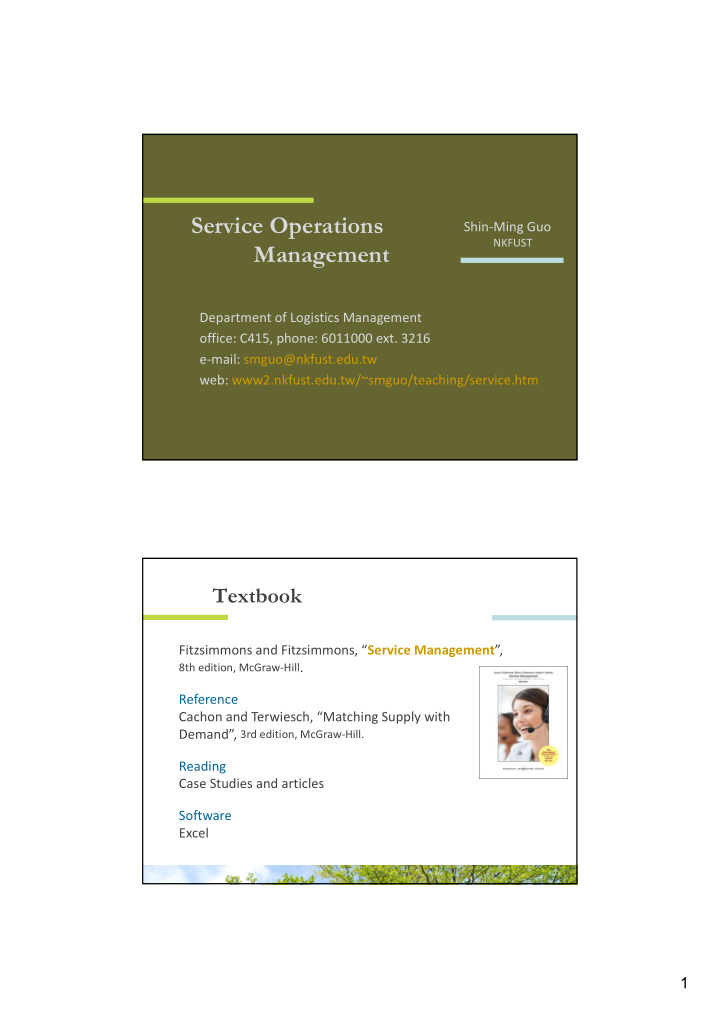



Service Operations Shin ‐ Ming Guo NKFUST Management Department of Logistics Management office: C415, phone: 6011000 ext. 3216 e ‐ mail: smguo@nkfust.edu.tw web: www2.nkfust.edu.tw/~smguo/teaching/service.htm Textbook Fitzsimmons and Fitzsimmons, “ Service Management ”, 8th edition, McGraw ‐ Hill . Reference Cachon and Terwiesch, “Matching Supply with Demand”, 3rd edition, McGraw ‐ Hill. Reading Case Studies and articles Software Excel 1
Tentative Course Outline 1 Introduction 2,3 Service Strategy and Service Packages 4 Service Encounter 5 Process Flows 6 Service Quality 11 Managing Capacity and Demand 12,13 Managing Waiting Lines 15 Managing Service Inventory Grading Homework 30% Report 30% Final Exam 30% Participation 10% No Social Media, No Plagiarism, No Cheating 2
Previous Topics for Team Report Loan Processing at Capital One — Process Improvement Ritz ‐ Carlton — Hiring and Training Taco Bell Corp. — Chain Store Operation Alaska Airline — Service Quality Which Products Should You Stock? — Inventory Management London Olympic Game — Revenue Management What is Service? Tangible or intangible? Customer involvement? Standardization or customization? Human or machine processing? Inventory and leftover? A service is a time ‐ perishable, intangible experience performed for a customer acting in the role of co ‐ producer. 3
Nature of Service Customer Participation : attention to facility design, opportunities for co ‐ production, concern for customer and employee behavior Simultaneity : opportunities for personal selling, interaction creates customer perceptions of quality Perishability : cannot inventory, opportunity loss of idle capacity, need to match supply with demand Intangibility : creative advertising, no patent protection, importance of reputation Heterogeneity : customer involvement in delivery process results in variability 7 Compare Manufacturing & Service Characteristic Manufacturing Service Product Tangible Tangible & Intangible Customer involvement Low High Uniformity of input High Low Labor content Low High Uniformity of output High Low Performance Measurement Easy Difficult Quality Control High Low Inventory Much Little or Perishable 4
Services: Nontransferrable Ownership Type of Service Customer value Examples Goods rental Obtain temporary right Vehicles, tools, furniture, to exclusive use equipment Place and space Obtain exclusive use of Hotel room, seat on rental defined portion of a airplane, storage unit larger space Labor and Hire other people to do a Car repair, surgery, expertise job management consulting Physical facility Gain admission to a Theme park, camp usage facility for a period of ground, physical fitness time gym Network usage Gain access to Electric utility, cell phone, participate internet 9 Moving to Experience Economy Economy Agrarian Industrial Service Experience Economic Food Packaged Commodity Consumer Business Offering goods service services services Function Extract Make Deliver Stage Co ‐ create Nature Fungible Tangible Intangible Memorable Effectual Attribute Natural Standardized Customized Personal Growth Method of Stored in Inventoried Delivered Revealed Sustained Supply bulk on demand over time over time Seller Trader Producer Provider Stager Collaborator Buyer Market Customer Client Guest Collaborator Expectation Quantity Features Benefits Sensations Capability 5
Competitive Environment of Services Relatively Low Overall Entry Barriers Economies of Scale Limited Erratic Sales Fluctuations No Power Dealing with Buyers or Suppliers Product Substitutions for Service High Customer Loyalty Hobby or job satisfaction High Exit Barriers 11 What is Operation Management? Transformation = Production = Service Physical: restaurants Location: transportation Exchange: retailing Storage: warehousing Physiological: health care Informational: telecommunications 6
How Can OM Improve a Service? Low Cost with Same Quality? Fast Delivery with Same …? Quality Service with Same …? Better Selection with Same …? More Revenue with Same …? Four Dimensions of Tradeoffs Quality Cost ▪ Product quality ▪ Efficiency ▪ Measured by: (how good?) ▪ Process quality ‐ cost per unit (as good as promised?) ‐ utilization Time Variety ▪ Responsiveness to ▪ Customer demand heterogeneity ▪ Measured by: ▪ Measured by: ‐ customer lead time ‐ number of options ‐ flow time ‐ flexibility / set ‐ ups 7
The Boarding Procedure Speed and Convenience for Passengers! On time performance and Cost for Airlines! Service Queuing Explained in Words and Pictures Call Center of Railroad Station Goal: 80% of incoming calls wait less than 20 seconds Starting point: 30% of incoming calls wait less than 20 secs. Problem: Must decide staffing levels of call centers and understand impact on efficiency Solution: Provides tools to support strategic trade ‐ offs 8
Revenue Management • The Park Hyatt Hotel has 118 rooms. • Regular fare is $225 targeting business travelers. • Empty rooms do not create any profit. • Hyatt offers $159 discount fare for a mid ‐ week stay targeting leisure travelers. Choice 1 : Accept low fare reservations without any limit. Choice 2 : Do not accept low fare reservation. Hope that high fare customers will eventually show up. 9
It’s the Details that Matter • Choice 3 : Accept low fare reservations but reserve rooms for high fare customers • Protection Level: the number of rooms reserved for higher fare customers. Protect too much Empty rooms Protect too little Turn away good customers • Problem: How to deal with no ‐ shows and last minute cancellations? Epilogue: Operation is Heart of Business Service Managers need to perform and make decisions in all functions. Operations account for 60 to 80% of the direct expenses that burden a firm’s profit. Operations directly affect customers and are essential to the competitiveness of the firm. 10
Recommend
More recommend